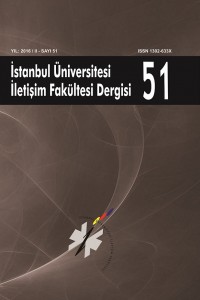CANLANDIRMA SİNEMASINDA ÜÇ BOYUTLU SANAL KARAKTERLERİN HAREKETLERİNİN VE FİZİKSEL ÖZELLİKLERİNİN ‘TEKİNSİZ VADİ’YE DÜŞMEDEKİ ETKİSİ
Öz
Çalışmada, Japon Robot Bilimci Masahiro Mori’nin ortaya koyduğu ‘Tekinsiz Vadi’ kavramı ele alınmak-
tadır. Mori’nin robotlar için ileri sürdüğü bu kavramdan yola çıkılan çalışmada, bilgisayar ortamında
üretilen ve canlandırma filmlerinde kullanılan üç boyutlu karakterler incelenmektedir. Üç boyutlu canlandırma filmlerinde gerçekçiliği yakalama isteği birçok defa denenmiştir. Günümüzdeki canlandırma
filmlerinde de, gerçek karakterlere yakın fiziksel görünüme sahip üç boyutlu karakterlerin yaratılmasıyla, gerçek bir oyuncuyla bilgisayarda üretilen karakterler arasındaki çizgi aşılmaya çalışılmaktadır. Bu
amaç doğrultusunda gerçekleştirilen canlandırma filmlerinin kimileri başarılı olurken, kimileri ise istenilen hedeflere ulaşamayarak, izleyiciler tarafından ilgiyle karşılanmamaktadır. Bu noktada filmlerdeki
karakterlerin izleyiciler tarafından ilgi çekici ya da itici bulunması ve bu durumun sonucunda filmlerin
Tekinsiz Vadi’ye düşüp düşmedikleri büyük bir önem taşımaktadır. Çalışmada, Tekinsiz Vadi’ye düşen ve
aşırı gerçekçi olarak nitelendirilebilecek kimi filmler incelenmiştir. Bu amaç doğrultusunda çalışmada
Beowulf (2007, Robert Zemeckis) ve Frozen (2013, Chris Buck, Jennifer Lee) adlı canlandırma filmlerdeki
üç boyutlu karakterlerin fiziksel özellikleri ve hareketleri üzerinden Tekinsiz Vadi’ye düşüp düşmedikleri
gerçekleştirilen odak grup çalışmasıyla saptanmıştır. Odak grup çalışmasından edinilen verilerden yola
çıkılarak Tekinsiz Vadi’ye düşen Beowulf filminin Tekinsiz Vadi’ye düşmesine neden olan karakterlerin hareketlerinin ve fiziksel özelliklerinin neler olduğu tespit edilmeye çalışılmıştır. Bu
amaç doğrultusunda gerçekleştirilen çalışmada ulaşılan sonuçlara bakıldığında filmlerdeki karakterlerin
gözlerinin Tekinsiz Vadi’ye düşmede ilk sıraya yerleştiği görülmektedir. Bu durumun arkasında gözlerdeki
donuk ifadenin payının büyük olduğu görülmektedir. Frozen tarzındaki
filmler ise sahip oldukları çizgisel yapı nedeniyle Tekinsiz Vadi’ye düşmemektedirler.
Abstract
This study deals with the concept of Uncanny Valley identified by the Japanese robotics professor, Masahiro Mori. Following this concept introduced by Mori for robots, three-dimensional computer-generated images that are produced in computer environment and used in animation films are analyzed. In order to overcome the line that causes difference between live and computer-generated images, three dimensional characters having similar features to live characters are created. While some of the animation films produced in accordance with this aim are considered successful, the others are not able to achieve desired goals and they are not admired by the audience. In this respect, it is highly important whether film characters are found interesting or repulsive. It is also significant whether those films fall into the category of Uncanny Valley or not. In accordance with this purpose, physical appearance and movements of three dimensional characters in the animation films, Beowulf (2007, Robert Zemeckis) and Frozen (2013, Chris Buck, Jennifer Lee) have been examined by using focus groups so as to detect whether these two films fall into Uncanny Valley or not. In the study by evaluating data obtained through focus groups, the movements and physical appearance of characters of the film Beowulf that cause the film to fall into the category of Uncanny Valley have been analyzed. The results of the study show that the eyes of the characters in the movies took the lead in falling into Uncanny Valley. The reason behind this situation can be explained by the great impact of the frozen expression in the eyes of the characters. On the other hand, the kind of movies like Frozen cannot be considered within the concept of Uncanny Valley because of their linear structure.
Keywords: Uncanny Valley, Three-Dimensional Animation, Realism
Anahtar Kelimeler
Kaynakça
- Aldred, J. (2011). From Synthespian to Avatar: Re-framing the Digital Human in Final Fantasy and The Polar Express. Retrieved from http://www.tft.ucla.edu/mediascape/Winter2011_Avatar. pdf
- Bartneck, C., Kanda, T., Ishiguro, H., Hagita, N. (2007). Is The Uncanny Valley An Uncanny Cliff, Human Interactive Communication (368-373). Korea: 16th IEEE International Conference on Robot.
- Bloor, M., Frankland, J., Thomas, M., Robson, K., (2001). Focus Groups In Social Research, Great Britain: SAGE Publications.
Ayrıntılar
| Bölüm | Makaleler |
|---|---|
| Yazarlar | |
| Yayımlanma Tarihi | 27 Aralık 2016 |
| Yayımlandığı Sayı | Yıl 2016 Sayı: 51 |


